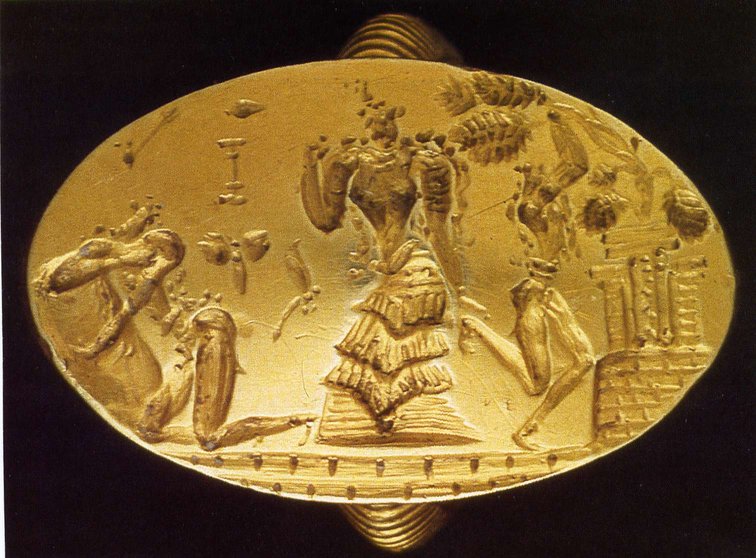The Sacred Cretan Mysteries — October 2015 Study Tour

The Sacred Cretan Mysteries on a 10 days Study tour!!!
Elissos Travelling Philosophy in collaboration with Mrs. Bonnie L. Damron, PhD, MSW Archetypal Pattern Analyst organizes a ten days Study tour in Crete on October 10th to 17th 2015 focusing on the Cretan Sacred Mysteries.
During our Study Seminar we will visit important Minoan sites of the north, east and south coast of Crete, we will explore Minoan sacred cave- temples and peak sanctuaries connected with the ancient Pre-Hellenic mysteries, we will hike down beautiful gorges and nature paths, we will experience authentic traditional areas and local crafts and we will participate in experiential ancient Geek arts such as music and dance!
Our aim?! To explore, reveal, connect with and experience the cultural, sacred, artistic and spiritual aspects of Crete! To see Crete «Through the eyes of the Goddess»!
An Introduction to the ancient Greek and Cretan Mysteries
The ancient Greek Mysteries in general
The word Mystery in ancient Greece meant the secret, the confidential, the sacred part of a ceremony or cult, which was not to be known to people uninitiated. Etymologically the word derives from the verb “Μυειν” “Miin” which means close/shut and it refers to the eyes and lips.
The ones initiated in the Mysteries of the transcendent, where not allowed to share their experience with the uninitiated, they had to keep their mouth shut.
The ancient Mysteries were perhaps the highest spiritual heritage in ancient Greece. They were mainly sacred and secret worshiping acts, in which one had first to become initiated, in other words to be introduced to the Mysteries. The follower of such a cult was called “Mυστης” “Mystis” and the person who introduced him to the Mysteries was called “Μυσταγωγος” “Μystagogos”. Every sacramental community had its own communal meals, communal dances and rites, and all members participating felt connected with each other for ever.
In their inner meaning, the Mysteries were presenting the eternal truth, natural or spiritual, which had been maintained for thousands of years.
From the very few sources that we have about the Mysteries, we know that they presented allegorical representations symbolizing the travel and destiny of the soul after death, the laws and divine unity which connects all beings, while several Mysteries were also rites for achieving the fruitfulness of the land, the cessation of earthquakes or the coveted advent of rain.
In ancient Greece there were always local Mysteries but also Mysteries of Panhellenic range such as the Eleusinian, the Orphic, the Kabeirian and the Cretan. Several academics believe that almost all Greek Mysteries were influenced from the ones of Egypt and were then reorganized by the great “Mystes” and Mysteries’ Leaders, the so called “Ierofantes”, who had served before in the big Egyptian temples such was Kadmos, Orpheus, Ferekidis, Epimenidis and Pyhtagoras.
In the Mysteries of all times and all cults, people seek the help and guidance of the God/Gods.
The Mysteries appear always at a quite advanced cultural stage of human beings, while the perception of the existence of Gods, spirits and of a whole transcendental Cosmos beyond the human ability of sensing, is the necessary precondition for the existence of the Mysteries.
The basic element in the performance of the Mysteries was the circle of the initiated. Yet in some Mysteries the uninitiated could participate too up to a point. This ensured the continuance of the Mysteries. Accepted in this case were only the ones succeeding in a series of tests and promises, while special emphasis was given to the mental elevation of the participants aiming their spiritual integration, through cleansing and purification rituals.
All world’s Mysteries were centered on the Mother Earth, who is called with different names in the different cultures. In the Greek culture she is called Rhea (Gea=Earth) or Demeter (Mother of Earth). Her worshiping starts in the prehistoric Aegean world, where she was not mentioned by any specific name as it appears. She was the Great Mother Earth symbol of the productive, revitalizing care of Nature with her parallels in west Asia Minor. In Minoan Crete she is the chthonic Goddess with the snakes, the “potnia”- Mistress of the animals and Lady of the Labyrinth.
In the most ancient Mysteries of the Aegean there is also the male annually dying God, such as in all Mysteries of Middle East. In Minoan Crete the strong fertility God (who appears in the form of a bull) is worshiped together with the young couple of the young God and daughter Goddess who die or disappear every autumn to come back again every spring, symbolizing the circle of life and vegetation.
In some of the later Greek Mysteries the dying God vanishes and his place takes the “Core”- Persephone. The heavenly husband still exists with various names e. g. Zeus, Poseidon, Iakchos or remains anonymous. In the Dionysian and Cretan Mysteries however the role of the dying God remains very important adopted then by Dionysos or Orpheus.
In the Aegean and later Greek world the Major Mysteries took place twice a year, in autumn when the sowing season and in spring when the crops needed rain.
The Sacred Mysteries of Crete
In ancient (Pelasgic) Crete the Cretan Mysteries were divided in two major categories:
– The Mysteries of the Great Mother Rhea- Earth
– The Mysteries of the Cretan born Zeus
In both categories the initiates were both men and women.
A detailed presentation of the Mysteries of Crete will take place during our October Study tour.
Article writing- research: Marilina Paters
Official Licenced Tourist Guide, PGC in pre-hellenic Ars-Mythology, Performer
